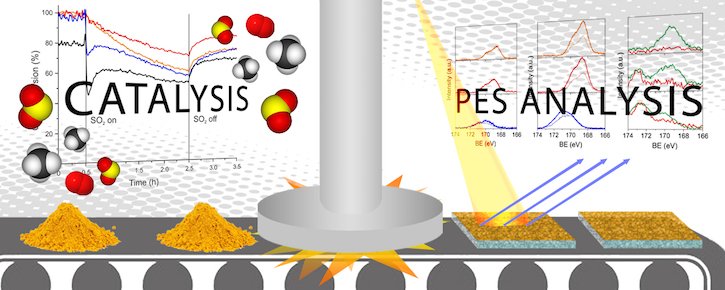Novel catalysts against climate change and for cleaner cities
|If you ever drove an old car or a diesel engine, you may have been affected by the most recent and increasingly stringent regulations on automotive emissions. Adoption of such regulations is the rule in major cities in Europe and all over the world to protect citizens against polluted air and increase their life quality and health. These regulations are slowly causing a paradigm shift in politics and car manufacturers away from the classic combustion engine to alternatives like electric or hydrogen fuel-cell driven cars.
While these concepts will be a long-term solution for the air pollution problems, in the short-middle term a less polluting hydrocarbon fuel can be used. Natural Gas Vehicles (NGV) are a more efficient and cleaner alternative to gasoline and diesel propelled cars and they could be a suitable mid-term solution. Unfortunately, their exhaust gases contain significant amounts of methane (CH4), a greenhouse gas 80 times as potent (in a 20 year time span) as carbon dioxide (CO2), the best-known greenhouse gas. To make the exhaust not only cleaner but also more climate-friendly, a method is needed to effectively eliminate methane.
A promising way of achieving this goal is the use of catalysts based on palladium (Pd) nanoparticles, which promote the efficient oxidation of methane with oxygen to carbon dioxide and water. To allow the exploitation of these highly expensive metal, such catalysts have been designed to maximize the contact between Pd nanoparticles and the promoter, which is composed of Cerium-Zirconium mixed oxides (CeO2-ZrO2), and is employed to favour the catalytic reaction. While the catalysts yield good results in the laboratory, under real life conditions many problems are still encountered, due to the complexity of the gaseous effluents from an internal combustion engine. In particular, the so-called poisoning by sulphur compounds, which are ever-present in natural gas, is a problem for a long life of the catalysts. Under working temperatures, the sulphur compounds are chemically bound to the Pd and the promoter material. This process could be irreversible and, over time, may suppress the catalytic performances.

To solve this problem, a team of researchers including Tiziano Montini and Matteo Monai from the University of Trieste, conducted a study in which they compared the sulphur poisoning of several catalysts under realistic conditions. To determine the influence of sulphur on the catalysts, they used a combination of activity and stability tests performed on real powdered catalysts, and spectroscopic characterization performed on comparable model materials. They used a combination of highly sensitive surface electron spectroscopy (XPS) and advanced microscopic techniques available at CERIC, that allow to make atoms visible. The findings of the study show that at lower temperatures sulphur binds directly on the Pd nanoparticles, while at working temperatures higher than 500 °C the promoter material is affected by sulphates adsorption. Among the promoter materials, the study suggests that pure ZrO2 is the most easily regenerated after poisoning. These results represent an important step towards the development of catalysts for real applications in cars with enhanced stability, to keep our air cleaner, for longer.



